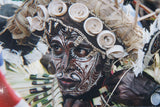Rare Older & unique handmade primitive Tribal Dani Shaman Head hunter collecting Bag, Bride price Currency strap handle, Baliem Valley Artifact, Irian Jaya, West Papua. Collected in the 1900’s.
UNIQUE AND RARE SHAMAN COLLECTING BAG HANDCRAFTED BY THE OWNER. SOLD
Rare Old Primitive Dani Warrior head Hunter Bag collected in the late 1900’s in the Baliem Valley, Irian Jaya, Papua New Guinea.
The tribe amulets hanging from the rim are made of bark Fiber, dingo Teeth, and shell pieces.
There are 2 large shell disks in the front and back which are actual currency and have trading value and are still used for money today. The handle is actually a money belt.
A huge amount of small nassa shells cover both sides entirely (hundreds or more as they are very tightly attached together)
Bag itself before the decorations were installed was handwoven with twine made from bark and natural vegetation.
We have sold such pieces to museums internationally.
It is in perfect shape and extremely decorative.
Item 160A130
Bag was used for magic, and good luck charms, herbs and dried out items, animal parts and plant parts used to cast spells. A powerful shaman or important hunter owned such a bag because of the valuable items that compose it.
This bag was extremely valuable on the premises as a trading object as it has currency value marking the worth and power of the owner such as large shell disks used as money to this day, and the handle which is a money belt, also a rare and important and a very valuable currency item. Money belts are strips of woven bark string with nassa shells sewn in, the longer the money belt is, the more valuable it becomes and can be used as an important trade item during feuds, paybacks, bride price events and ceremonies.
All our collector and rare items come with pages and pages of research about provenance, and with history of the tribes and photos as well, depending on item and whenever possible. When shipping internationally, we group ship multiple purchases to save you money, and look for the best rates. If you have any questions or want to see research conducted on this piece and photos of tribes, let us know.







































